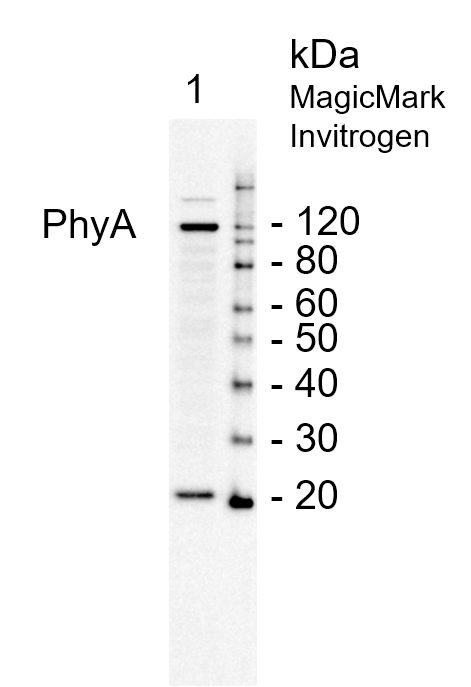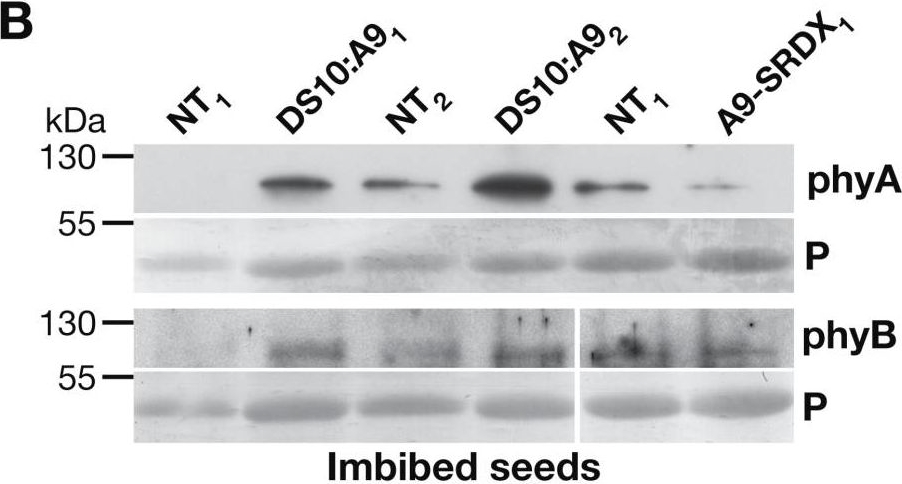1

Anti-PhyA | Phytochrome A
AS07 220 | Clonality: Polyclonal | Host: Rabbit | Reactivity: Arabidopsis thaliana, Nicotiana benthamiana, Nicotiana tabacum
- Product Info
-
Immunogen: KLH-conjugated synthetic peptide derived from conserved plant PhyA protein sequences including Arabidopsis thaliana UniProt:P14712, TAIR:At1g59070; peptide sequence is not present in other plant phytochrome forms (B-E)
Host: Rabbit Clonality: Polyclonal Purity: Immunogen affinity purified serum in PBS pH 7.4. Format: Lyophilized Quantity: 50 µg Reconstitution: For reconstitution add 50 µl of sterile water Storage: Store lyophilized/reconstituted at -20°C; once reconstituted make aliquots to avoid repeated freeze-thaw cycles. Please remember to spin the tubes briefly prior to opening them to avoid any losses that might occur from material adhering to the cap or sides of the tube. Tested applications: Western blot (WB) Recommended dilution: 1 : 1000 (WB) Expected | apparent MW: 124 kDa
- Reactivity
-
Confirmed reactivity: Arabidopsis thaliana, Arachis hypogaea L., Nicotiana benthamiana, Nicotiana tabacum
Predicted reactivity: Brassica rapa, Cardamine hirsuta, Dacucus carota, Lathyrus sativus, Fragaria ananassa, Glycine max, Gossyoium hirsutum, Hordeum vulgare, Lotus corniculatus, Medicago truncatula, Nicotiana benthamiana (PhyA1), Nicotiana tabacum, Oryza sativa, Pisum sativum, Populus balsamifera, Ricinus communis, Solanum lycopersicum
Species of your interest not listed? Contact usNot reactive in: No confirmed exceptions from predicted reactivity are currently known - Application Examples
- Application example

10 µg of total protein extracted with PEB (AS08 300) from etiolated seedlings of Arabidopsis thaliana (1) was separated on 4-12% NuPage (Invitrogen) LDS-PAGE and blotted 2h (30V) to nitrocellulose. Filter was blocked 1h with 2% low-fat milk powder in TBS-T (0.1% TWEEN 20) and probed with anti-PhyA (AS07 220, 1:1000, 19.5h) and secondary anti-rabbit (1:20000, 1h) antibody (HRP conjugated) in TBS-T containing 2% low fat milk powder. Antibody incubations were followed by washings in TBS-T (15, +5, +5, +5 min). All steps were performed at RT with agitation. Signal was detected with chemiluminescent detection reagent, using a Fuji LAS-3000 CCD (300s, standard sensitivity).
Application examples: 
Reactant: Nicotiana tabacum (Common tobacco)
Application: Western Blotting
Pudmed ID: 28207924
Journal: J Exp Bot
Figure Number: 5B
Published Date: 2017-02-01
First Author: Prieto-Dapena, P., Almoguera, C., et al.
Impact Factor: 6.088
Open PublicationEffects of HSFA9 in seeds and seedlings before the first exposure to light. (A) Changes in transcript levels for COP1, PHYA, PHYB, and HY5 in DS10:A9 seeds, and converse trend as determined by RT-qPCR, in seeds from the loss-of-function DS10:A9-SRDX lines. The seeds were imbibed under darkness for 24 h. Two to three different DS10:A9 or two to four DS10:A9-SRDX pairs of homozygous transgenic/non-transgenic (NT) sibling lines were analysed in at least two experiments. Error bars denote the SEM. The asterisks denote that all fold-changes were statistically significant (the depicted ratios were different from 1; see Supplementary Table S3). (B) Enhanced accumulation of phyA and phyB antibody-reacting proteins under darkness in imbibed seeds and seedlings. Top: seeds imbibed for 24 h, results depicted for the indicated sibling pairs of NT/DS10:A9 and NT/DS10:A9-SRDX (A9-SRDX) lines. Bottom: seedling results illustrated for two different sibling pairs of NT and 35S:A9 lines. The putative phyA band disappears (as expected) after illumination for 6 h with white light (Light). Equal loading of total protein in samples was verified with Ponceau S staining (P).
- Additional Information
-
Additional information: In vivo pull down assay for PhyA and western blot analysis of eluted proteins is described in Paik et al. (2012). Phytochrome regulates translation of mRNA in the cytosol. PNAS 109 (4): 1335-1340. Additional information (application): Careful sample collection is adviced to assure the best results with this antibody - Background
-
Background: Phytochrome A (PhyA) is the primary photoreceptor mediating various responses to far-red (FR) light in plants. Alternative protein names: FAR RED ELONGATED HYPOCOTYL 2, FAR RED ELONGATED 1, ELONGATED HYPOCOTYL 8.
- Product Citations
-
Selected references: Staudt et al. (2023). EID1 promotes the response to canopy shade in Arabidopsis thaliana by repressing the action of phytochrome A. MicroPubl Biol. 2023 Dec 12:2023:10.17912/micropub.biology.001015.doi: 10.17912/micropub.biology.001015.
Schwenk et al. (2021) Uncovering a novel function of the CCR4-NOT complex in phytochrome A-mediated light signalling in plants. Elife. 2021 Mar 30;10:e63697. doi: 10.7554/eLife.63697. PMID: 33783355; PMCID: PMC8009681.
Schenk et al. (2021) Light-induced degradation of SPA2 via its N-terminal kinase domain is required for photomorphogenesis, Plant Physiology, 2021;, kiab156, https://doi.org/10.1093/plphys/kiab156
Menon et al. (2019). Arabidopsis FAR-RED ELONGATED HYPOCOTYL 1 and FHY1-LIKE are not required for phytochrome A signal transduction in the nucleus. Plant Communications. Available online 9 November 2019, 100007.
Agliassa et al. (2018). Geomagnetic field impacts on cryptochrome and phytochrome signaling. J Photochem Photobiol B. 2018 Aug;185:32-40. doi: 10.1016/j.jphotobiol.2018.05.027.
Zhang et al. (2018). Characterization of peanut phytochromes and their possible regulating roles in early peanut pod development. PLoS One. 2018 May 25;13(5):e0198041. doi: 10.1371/journal.pone.0198041.
Pierto-Dapena et al. (2017). Seed-specific transcription factor HSFA9 links late embryogenesis and early photomorphogenesis. J Exp Bot. 2017 Feb 16. doi: 10.1093/jxb/erx020.
Paik et al. (2012). Phytochrome regulates translation of mRNA in the cytosol. PNAS 109 (4): 1335-1340. - Protocols
-
Agrisera Western Blot protocol and video tutorials
Protocols to work with plant and algal protein extracts - Reviews:
-
Emilie | 2017-06-07Total proteins (20 µg) from 4 day-old light grown seedlings were separated on 8% SDS PAGE and transfer onto nitrocellulose. 1/1000 dilution of anti-phyA antibodies revealed multiple bands at around 120 kDA, but one was absent in phya mutant.



